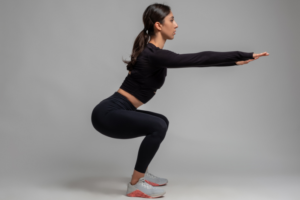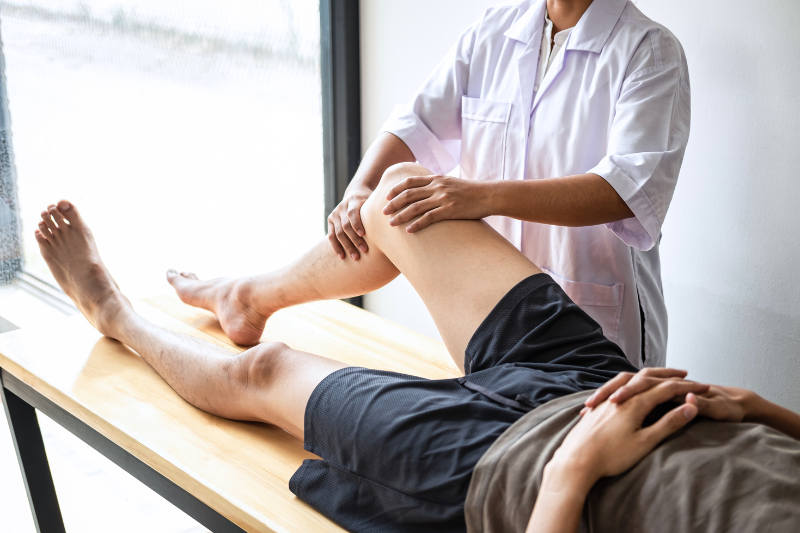Common Causes of Knee Pain in Active Adults
Knee pain is a common issue among active adults in our Markham community. Understanding the root causes is crucial for effective treatment and prevention. Let’s explore the main factors that contribute to knee pain in our community.
Osteoarthritis and Its Impact on Knee Health
Osteoarthritis is a common cause of knee pain among middle-aged to senior adults. This degenerative joint condition occurs when the protective cartilage that cushions the ends of your bones wears down over time. At Form & Function Markham, we frequently see patients dealing with the effects of osteoarthritis on their knee health.
The impact of osteoarthritis on knee health can be significant. Patients often experience pain, stiffness, and reduced range of motion in their knees. These symptoms can make daily activities like climbing stairs or getting up from a chair challenging. For our active patients in Markham, osteoarthritis can also interfere with sports and exercise routines.
While osteoarthritis is a progressive condition, there are many effective treatment options available. At our clinic, we develop personalized treatment plans that may include physical therapy, targeted exercises, and innovative therapies like cold laser treatment. Our goal is to manage pain, improve joint function, and help you maintain an active lifestyle despite osteoarthritis.
Sports-Related Knee Injuries in Markham
Our active community in Markham and Unionville often faces sports-related knee injuries. These can range from minor sprains to more severe ligament tears. Common injuries include meniscus tears, ACL (anterior cruciate ligament) injuries, and patellar tendinitis.
We’ve treated numerous patients who’ve injured their knees playing sports like soccer, basketball, or tennis. These injuries can occur due to sudden twisting movements, direct impacts, or overextension of the knee joint. Proper warm-up, conditioning, and using the right techniques can help prevent many of these injuries.
Overuse and Repetitive Strain Injuries
Overuse injuries are increasingly common among active adults in our area. These injuries develop gradually when we repeatedly stress our knees without adequate rest or proper conditioning. Patellofemoral pain syndrome (PFPS), also known as runner’s knee, is a prime example of an overuse injury I often see in my practice.
Muscular imbalances play a significant role in these injuries. Weakness or tightness in the muscles around the knee or hips can alter knee mechanics and contribute to pain. Additionally, biomechanical factors like flat feet or knocked knees can lead to altered loading of the knee and contribute to overuse injuries.
Diagnosing Knee Pain: Steps for Markham Residents
Accurate diagnosis is crucial for effective knee pain treatment. As a Markham resident experiencing knee discomfort, understanding when to seek professional help and what diagnostic techniques are available can significantly improve your treatment outcomes.
When to Seek Professional Help for Knee Pain
If you’re dealing with knee pain it’s important to know when it’s time to consult a specialist. Mild discomfort that goes away with rest or basic home care usually doesn’t require immediate medical attention. However, certain symptoms indicate a need for professional evaluation.
You should seek help if you experience persistent pain lasting more than a few days, significant swelling, inability to bear weight on the affected leg, or if the pain interferes with your daily activities or sleep. Additionally, any signs of infection like redness, warmth, or fever warrant immediate medical attention.
Diagnostic Techniques Used by Physiotherapists in Markham
When you visit a Physiotherapist in Markham, ensure that you find someone who predominantly works with knee injuries. They’ll use various diagnostic techniques to pinpoint the root cause of your pain. The process typically starts with a thorough history of the injuries followed by a detailed physical examination. This helps identify potential risk factors and the nature of your symptoms.
Functional activity assessments are a crucial part of diagnosis. These may include observing your gait, testing your range of motion, and evaluating how your knee responds to different movements. Such assessments provide valuable insights into how your knee pain affects your daily activities and can guide treatment planning. At Form & Function Markham we use Functional Movement Screens and Selective Functional Movement Analysis and various other techniques to find the movement limitations you may have.
In some cases, imaging tests may be necessary. X-rays can reveal bone problems or arthritis (joint inflammation and degeneration), while MRI scans provide detailed images of soft tissues like ligaments and cartilage. Sometimes, blood tests or joint fluid analysis might be recommended to rule out certain conditions. These diagnostic techniques help ensure you receive the most appropriate and effective treatment for your specific knee issue if conventional testing and treatments are not effective.
Non-Surgical Knee Pain Treatment Options in Markham
Physical Therapy and Rehabilitation Programs
At Form & Function Markham, we specialize in tailored physical therapy and rehabilitation programs for knee pain and knee injuries. Our approach combines hands-on techniques with targeted exercises to address the specific diagnosis
Our rehabilitation programs focus on strengthening the muscles around the knee joint, improving flexibility, and enhancing overall knee stability. We utilize a variety of techniques, including manual therapy, therapeutic exercises, and proprioceptive training inside our 20,000 sister gym Unionville Athletic Club. These methods are designed to reduce pain, improve range of motion, and restore proper knee function while building resilience to prevent future occurances.
For our patients dealing with conditions like osteoarthritis or recovering from knee injuries, or full knee replacement, we develop personalized treatment plans where we can support you remotely to ensure your are progressing well with your programs. These plans often include a combination of in-clinic sessions and home exercise programs using tools like Phyxable. Our goal is not just to alleviate current pain, but also to equip you with the tools and knowledge to maintain knee health long-term.
Innovative Therapies: Cold Laser and Shockwave Treatment
At Form & Function Markham, we offer cutting-edge therapies for knee pain that are covered by many insurance plans. Cold laser therapy and shockwave treatment are two innovative options that have shown promising results for our patients in Markham and Unionville.
Cold laser therapy, also known as low-level laser therapy, uses specific wavelengths of light to stimulate healing and reduce inflammation in the knee joint. This non-invasive treatment can be particularly effective for conditions like osteoarthritis and patellofemoral pain syndrome. Many of our middle-aged patients appreciate its painless application and the absence of side effects.
Shockwave therapy, on the other hand, uses acoustic waves to promote healing and pain relief. It’s especially beneficial for treating chronic knee conditions and can help stimulate blood flow and tissue regeneration for more chronic issues. Our Markham patients often report significant improvements in knee pain and function after a series of shockwave treatments.

These state-of-the-art therapies can be used alone or in combination with other treatment modalities to create a comprehensive knee pain management plan. We tailor each treatment to your specific needs, ensuring you receive the most effective care for your knee condition.
Regenerative Medicine: PRP and Stem Cell Therapies
At Form & Function Markham, we understand that some knee conditions may benefit from advanced regenerative medicine techniques. While we don’t offer these treatments directly, we have established strong relationships with trusted specialists in the Markham and Unionville area who provide Platelet-Rich Plasma (PRP) and stem cell therapies.
PRP therapy involves using a concentration of a patient’s own platelets to accelerate the healing of injured tendons, ligaments, muscles, and joints. For our middle-aged patients dealing with chronic knee pain or osteoarthritis, PRP can be a promising option. It’s particularly effective in stimulating tissue repair and reducing inflammation, potentially delaying or even avoiding the need for more invasive procedures.
Stem cell therapy, another cutting-edge treatment, uses the body’s own stem cells to promote healing and regeneration of damaged knee tissues. This can be especially beneficial for patients with cartilage damage or degenerative conditions. While these treatments are still evolving, many of our patients have reported significant improvements in pain levels and function after undergoing these procedures with our referred specialists.
Minimally Invasive Procedures for Knee Pain Relief
While our focus at Form & Function Markham is on non-surgical treatments, we recognize that some knee conditions may require minimally invasive procedures. These options can provide significant relief for our middle-aged who haven’t found success with conservative treatments.
Arthroscopy is a common minimally invasive procedure that allows orthopedic surgeons to diagnose and treat various knee problems. Using small incisions and a tiny camera, surgeons can repair meniscus tears, remove loose cartilage, or address ligament injuries. Many of our patients who’ve undergone arthroscopy report quicker recovery times and less post-operative pain compared to traditional open surgery.
For those dealing with chronic knee pain due to osteoarthritis, viscosupplementation injections can be an effective option. This procedure involves injecting a gel-like substance into the knee joint to improve lubrication and shock absorption. While not a permanent solution, many of our Markham patients find these injections provide significant pain relief and improved mobility for several months.
Remember, while these procedures can be beneficial, they’re typically considered after conservative treatments have been exhausted. At Form & Function Markham, we’ll work closely with you to determine the most appropriate treatment path for your specific knee condition and lifestyle needs.
Exercise Routines for Strengthening Knee Joints
At Form & Function Markham, we’ve developed effective exercise routines specifically designed for middle-aged adults dealing with knee pain. These exercises focus on strengthening the muscles around the knee joint, improving flexibility, and enhancing overall knee stability.

Our routines typically include low-impact exercises that are gentle on the knees. These may include stationary cycling, swimming, or using an elliptical machine. These activities help improve cardiovascular health while minimizing stress on the knee joints. For muscle strengthening, we often recommend exercises like leg presses, hamstring curls, and calf raises, which can be performed safely in our fully-equipped gym at Unionville Athletic Club.
We also emphasize the importance of core and hip strengthening exercises. A strong core and stable hips can significantly reduce the load on your knees during daily activities. Exercises like planks, bridges, and hip abductions are integral parts of our knee strengthening programs. Remember, it’s crucial to start slowly and gradually increase the intensity of your exercises under professional guidance to prevent further knee injuries.
Nutrition and Weight Management for Knee Health
At Form & Function Markham, we emphasize the importance of nutrition and weight management in maintaining knee health. For our middle-aged patients in Markham and Unionville, managing body weight is crucial in reducing stress on the knee joints, especially for those dealing with osteoarthritis or recovering from knee injuries.
A balanced diet rich in anti-inflammatory foods can significantly impact knee health. We recommend incorporating foods high in omega-3 fatty acids, such as salmon and walnuts, as well as colorful fruits and vegetables that are packed with antioxidants. These nutrients help combat inflammation in the body, potentially reducing knee pain and supporting overall joint health.
For our patients struggling with weight management, we often collaborate with local nutritionists to create personalized meal plans. Even a modest weight loss can dramatically reduce the load on your knees. For instance, losing just 10 pounds can decrease the force on your knees by 30-60 pounds with each step. This reduction in joint stress can lead to significant improvements in knee pain and function. We also work closely with personal trainer at Unionville Athletic Club in helping you achieve those goals.
Proper Techniques for Sports and Physical Activities
At Form & Function Markham, we emphasize the importance of proper techniques during sports and physical activities to protect your knees. For our middle-aged patients in Markham and Unionville, using the correct form can significantly reduce the risk of knee injuries and alleviate existing knee pain.
When engaging in activities like running or cycling, maintaining proper alignment is crucial. We teach our patients to keep their knees in line with their toes and avoid excessive inward or outward rotation. For runners, we recommend a midfoot strike rather than heel striking, which can reduce the impact on the knees.

For strength training exercises, we stress the importance of proper form. When performing squats or lunges, we guide our patients to keep their knees behind their toes and maintain a neutral spine. We also emphasize the need for gradual progression in intensity and weight to prevent overloading the knee joints. This is where the results of the Functional Movement Screens will help us personalize a program for our patients.
Remember, warming up before any physical activity and cooling down afterward are essential for knee health. We provide our patients with specific warm-up routines that prepare the knees for activity and cool-down stretches that help maintain flexibility and reduce post-exercise stiffness.
Ergonomic Considerations for Daily Activities
At Form & Function Markham, we understand that daily activities can significantly impact knee health. For our middle-aged patients in Markham and Unionville, we emphasize the importance of ergonomic considerations to reduce stress on the knees. This includes proper posture while sitting and standing, using supportive chairs, and avoiding prolonged periods of inactivity.
One effective solution we offer is custom-fitted knee braces. These braces provide targeted support and can be particularly beneficial for patients with osteoarthritis, ligament injuries, or general knee instability. Our team of experts performs thorough assessments to determine the most suitable brace for each individual’s needs and lifestyle.
We’re proud to offer a wide range of high-quality knee braces, with custom fitting services covered by most insurance plans. This means our Markham and Unionville patients can access top-tier knee support without significant out-of-pocket expenses. The right brace can make a substantial difference in managing knee pain, improving stability, and allowing for more comfortable participation in daily activities.
Remember, while knee braces can be highly effective, they’re often most beneficial when used as part of a comprehensive treatment plan. Our team at Form & Function Markham will work with you to integrate bracing with other treatments like physical therapy, exercise routines, and ergonomic adjustments to ensure optimal knee health and function.
Factors to Consider When Selecting a Treatment Plan
When selecting a knee pain treatment plan at Form & Function Markham, we consider several crucial factors to ensure the most effective approach for our middle-aged patients in Markham and Unionville. The severity and duration of your knee pain play a significant role in determining the appropriate treatment. Acute injuries may require different interventions compared to chronic conditions like osteoarthritis.
Your overall health status and any pre-existing medical conditions are also important considerations. For instance, if you have diabetes or heart disease, certain treatments may be more suitable than others. We also take into account your lifestyle and activity level. An avid tennis player will have different treatment needs compared to someone with a more sedentary lifestyle.
Finally, we consider your personal goals and preferences. Some patients may prefer non-invasive treatments like physical therapy and cold laser therapy, while others might be open to more advanced options like PRP therapy. At Form & Function Markham, we work closely with you to create a personalized treatment plan that aligns with your specific needs, lifestyle, and health objectives.
Top-Rated Knee Pain Specialists in Markham and Unionville
At Form & Function Markham, we pride ourselves on being one of the top physiotherapy and chiropractic teams in Markham and Unionville when it comes to knee pain treatment. Our specialized approach combines cutting-edge techniques with years of experience to provide effective solutions for middle-aged adults struggling with knee issues.
Our team of knee pain specialists includes highly trained physiotherapists and chiropractors who focus on personalized treatment plans. We understand that each patient’s knee pain is unique, which is why we tailor our approach to your specific needs, lifestyle, and health goals. Our expertise covers a wide range of knee conditions, from osteoarthritis to sports-related injuries.
We work closely with other top-rated specialists in the area, including orthopedic surgeons and sports medicine physicians, to ensure comprehensive care for our patients. This collaborative approach allows us to offer a full spectrum of treatment options, from conservative therapies to advanced regenerative medicine techniques when necessary.
About Physiotherapist Afshin Sham.
Afshin’s clinical practice involves a comprehensive approach, beginning with a thorough anatomical, biomechanical and neurophysiological assessment to identify sources of nociception (painful stimuli). Afshin’s treatments consist of manual techniques and neurofunctional electro-acupuncture in addition to prescribed home exercises for the rehabilitation and prevention of sports injuries and pain with movement disorders.
Afshin received his Bachelor of Science in Kinesiology from York University. He then went on to complete his Physiotherapy degree at the European School of Physiotherapy in Amsterdam, Netherlands with special interests in musculoskeletal/sports rehabilitation, injury prevention and performance enhancement.
Afshin has completed post-graduate courses in Contemporary Medical Acupuncture from McMaster University as well as the Advanced Integrated Musculoskeletal (AIM) program through the Orthopaedic Division of the Canadian Physiotherapy Association.
If you would like to book a session with Afshin, click below to schedule an appointment.















